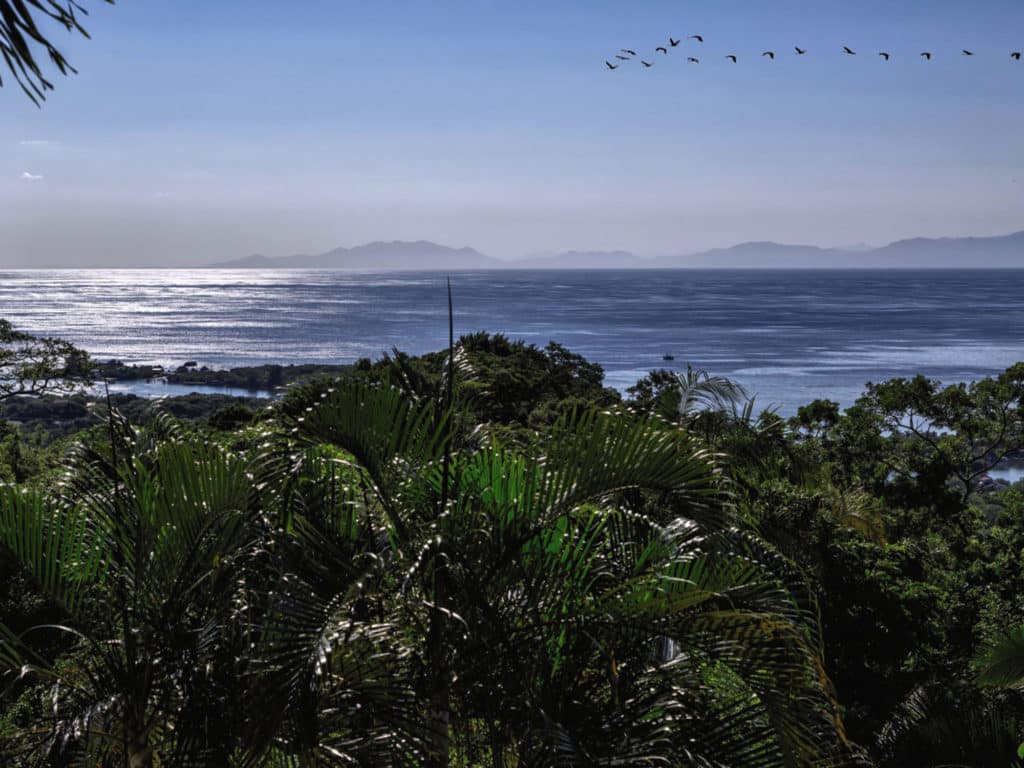
Coronavirus. Coronavirus! Can anyone think of anything else? One night I awoke in the V-berth after midnight, convinced I had the virus. My head hurt, my stomach felt queasy, and I sensed a fever coming on. Little sleep followed. In the morning, my saner self prevailed. It was a little absurd for me to be so worried, because, at the time, there were no confirmed cases of the virus on the island of Roatan, where we were docked. I wrote off my symptoms to consuming an unhealthy dose of world news.
When my husband, Ken, and I sailed from Belize to Roatan, one of the Bay Islands off the coast of Honduras, the novel coronavirus was barely on our radar. Approaching at sunrise on February 28, 2020, the long, narrow island, silhouetted in gold, slowly emerged from the sea. Discovering a new place by boat is always exhilarating. Blinded by the sun, I struggled to spot the red and green markers indicating a break in the reef at the edge of West End’s mooring field. We recognized a few of the moored boats from Rio Dulce, Guatemala, which is where we’d docked our Morgan 38, Mary T, for the past five years.
West End, at the western tip of Roatan, turned out to be a quaint, touristy town with a laid-back vibe and a diverse population. As part of Honduras, Spanish is the official language, but the island has its own cultural identity influenced largely by the descendants of British invaders and Black Caribs. We heard Garifuna, Creole, English and Spanish spoken on the street. The topography is lush and hilly, and on a clear day, you can see the rugged mountain range 40 miles to the south on the mainland. West End’s bustling waterfront strip is lined with a wide variety of restaurants, dive operations, and craft vendors plying their wares. We’d just begun to explore this gem of a town and barely had a chance to snorkel the reef when we were chased away by the weather. The mooring field is protected only from the east, so everyone clears out when a fierce norther is predicted.
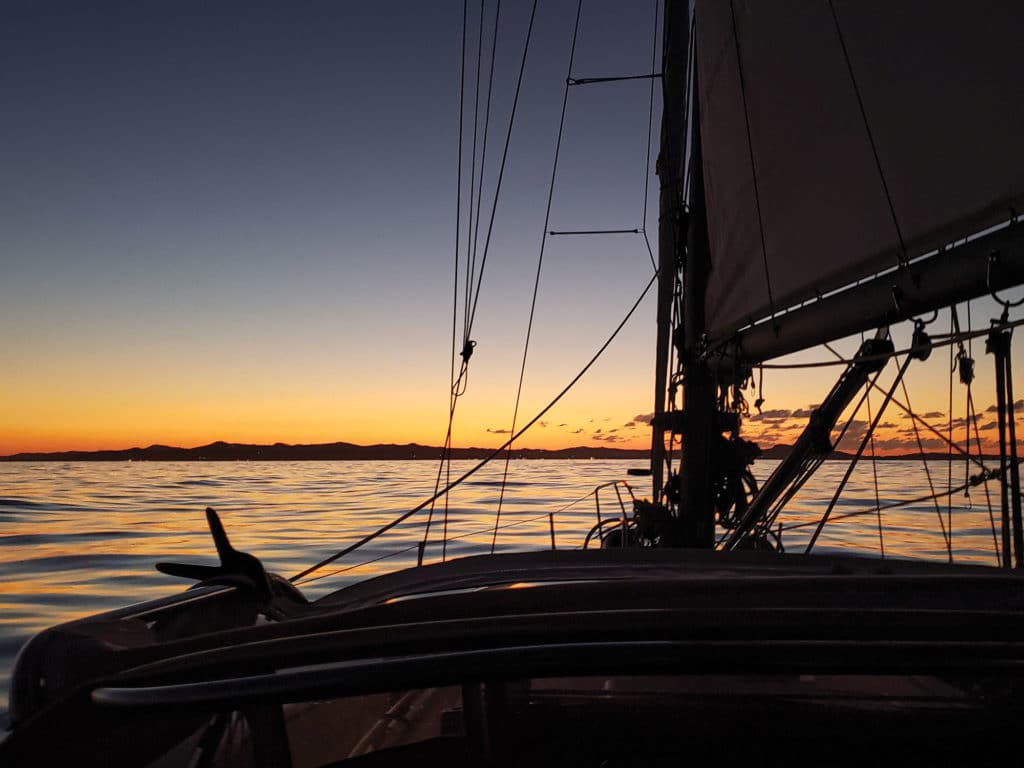
Following a small caravan of boats, we rounded the island, heading for French Cay Harbor on the southern shore of Roatan. Waypoints given to us by other cruisers proved critical in entering the anchorage, which involved some bobbing and weaving through the reef. To the south lay Little French Cay and Big French Cay, tourist hubs frequented primarily by cruise-ship patrons who were ferried over for a day to gawk at the caged tigers, horseback ride and snorkel. To the northeast lay Fantasy Island, home to an all-inclusive resort and marina. The town of French Harbor on Roatan proper is a fishing port with a large commercial fleet. There’s no real town center, but we discovered some decent restaurants, good provisioning emporiums such as Ace Hardware, and a well-stocked supermarket.
The US Embassy started sending out emails, urging American citizens to leave as soon as possible or risk being stuck.
After a few stormy days at anchor involving some dragging, we decided to indulge in a slip at Fantasy Island to take advantage of the resort’s amenities. It would be nice to have electricity and water for a while, and enjoy the beautiful crescent-shaped beach. I arose early in the mornings, walked to the beach, and swam in the calm, crystal-clear water. Then I’d head over to the gazebo perched on the edge of the reef, and descend the steps to snorkel. Roatan is a mecca for divers, and the reef at French Harbor is reminiscent of an elaborate Dale Chihuly glass sculpture—nature imitating art.
While we were exploring, snorkeling, and sipping fancy cocktails in restaurants with sweeping views, the pandemic was steadily creeping across the globe. Ken and I resolved to become more vigilant hand-washers and do fist bumps instead of handshakes, just in case. Then suddenly, in mid-March, the owner of Fantasy Island Resort told all the guests to pack their bags because Roatan’s seaports and airport were shutting down imminently. The resort would be closing, but boaters were permitted to stay. The US Embassy started sending out emails, urging American citizens to leave Roatan as soon as possible or risk being stuck. These warnings, coupled with the increasingly frightening news of the sometimes-lethal virus, engendered a high level of anxiety, especially in my husband, whose health is somewhat compromised. We prayed that the numerous cruise ships we’d seen in port had not left the virus in their wake. The idea of being marooned, without adequate medical care, was unsettling. Fortunately we had our own mode of transportation. We decided to embrace living in the moment and not do anything rash. After all, we were in paradise.
A few days after tourists started clearing out, the Honduran government declared a state of emergency and imposed a curfew. Taxis and public transportation stopped operating; schools and all but essential businesses closed. The resort owner cut off our electricity with no warning or explanation. Apparently it wasn’t worth running the generator for just a few boats. Fortunately our solar panels kept the fridge running. The dockmaster and his Canadian wife caught a flight out to Canada, and the new dockmaster put a moratorium on yoga, potlucks and large gatherings at the marina bar. On the bright side, we had the beach all to ourselves.
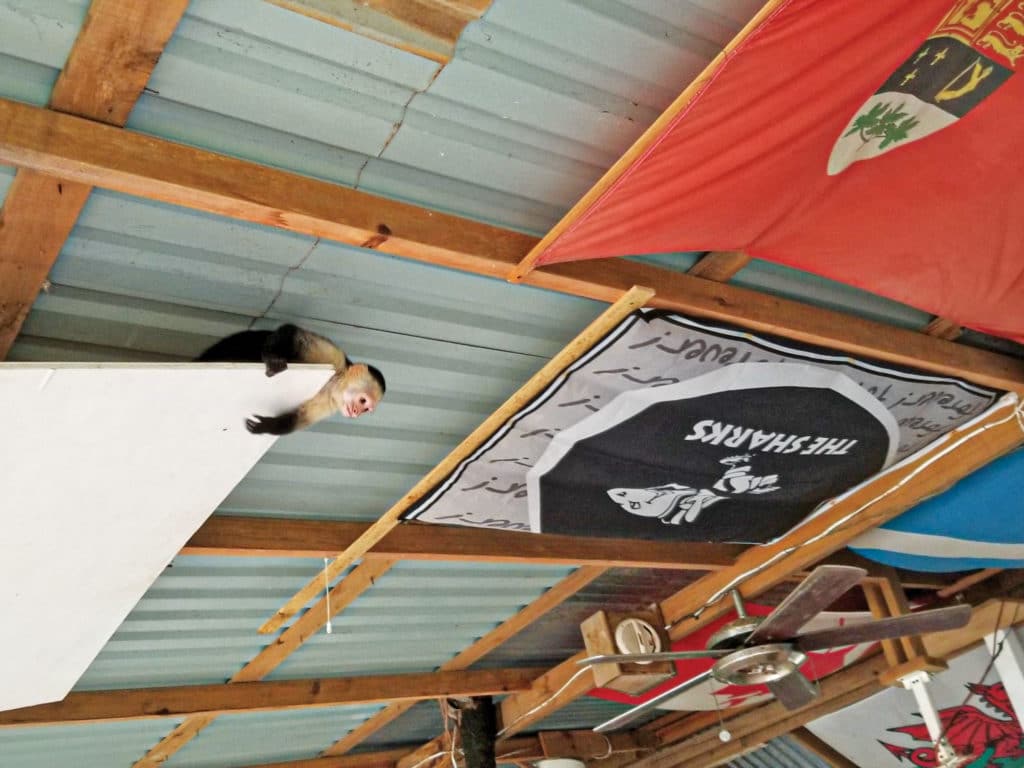
Little by little, the marina and anchorage started thinning out. Some sailed away, while others chose to fly home, leaving their vessels behind. About a dozen occupied boats remained. Every morning, Ken and I took walks around Fantasy Island, counting our blessings and collecting coconuts. We’d run into others doing the same and stop for a socially distant chat. Brazen peacocks, free-range chickens, and cute guinea-pig-like rodents called agoutis roamed among us. We’d fill the afternoons with swimming or snorkeling and noted how much cleaner the water looked since the resort closed. In the evenings, we’d dive into the cocktail hour with family members online. They talked about sheltering in place and toilet paper shortages. Folks back home seemed to be simultaneously envious and concerned about our situation. The setting looked lovely and we had plenty of toilet paper, but how and when would we come home? And what if we had a serious health concern? The fact that over a week into the lockdown there were still no confirmed cases of COVID-19 in Roatan was reassuring to everyone.
As time went on, the governor of Roatan established increasingly stricter rules. The island was completely closed off, though expensive charter flights could be arranged if you knew the right people. Not even residents of the island were allowed to return if they’d been off island when the lockdown was implemented. Authorities and locals patrolled the surrounding waters for intruders. When 15 Honduran policemen sneaked in from the mainland on a military transport ship, the locals protested vehemently. The policemen were quickly rounded up and shipped back to the mainland, where they were tested for the virus. Cruisers were forbidden to move their boats to other ports or to the other Bay Islands of Utila and Guanaja. If we left, there would be no returning. Only ships bringing essentials such as food were permitted in, and their crews were not allowed ashore.
Roatan’s governor addressed the public every day on Facebook in Spanish and English, updating everyone on the latest restrictions and stressing the importance of keeping the number of COVID-19 cases to zero. We were permitted to patronize large stores or banks only one day a week. The last digit of our passport or ID card determined which day we were allowed out. Wearing masks was mandatory at Eldon’s Supermarket, and an employee spritzed sanitizer onto your hands upon entry. They even wiped down the shopping carts. We respected and admired all the precautions being taken.
After a month, life at the marina was losing its charm. The mangroves were encroaching on Mary T, and the fresh water was cut off on our dock. Ken and I decided to move to the only other marina in French Cay Harbor: Brooksy Point Yacht Club. The Roatan Port Captain gave his approval for us to move the short distance. We were a small group at BPYC because most of the boats were unoccupied, but our cruising friends made it festive: decorating the lounge area and hosting potlucks and movie nights. Though we appreciated the activities from afar, we continued to practice social distancing. I wondered if we were being overly cautious. It was over a month into lockdown, and no COVID-19 tests on the island had come back positive. Maybe I was listening to too much international news and identifying with a set of circumstances that didn’t really apply to us.
We missed our beach walks on Fantasy Island, so for exercise, we marched up and down the steps from the open-air cruisers’ lounge to the street level in what Ken called our M.C. Escher-like exercise. Occasionally, we’d go for a stroll through the neighborhood or visit the nearby iguana reserve created by Sherman Arch, a descendant of British settlers. A generous soul and dedicated environmentalist, Arch established French Harbor’s marine reserve, which he personally patrolled for poachers.
Our world was becoming ever smaller, but we always reminded ourselves how fortunate we were. Across the globe, people were suffering from the pain and loss engendered by this insidious virus, while we had everything. We were in a beautiful place with world-class snorkeling. We had plenty to eat, our own boat, and we could sail away. Many islanders lived hand to mouth and survived off the tourist trade, so a lot of families were feeling the economic hardship of the pandemic. The wealthier islanders, expats and cruisers donated to local charities to feed the hungry. It was the very least we could do.
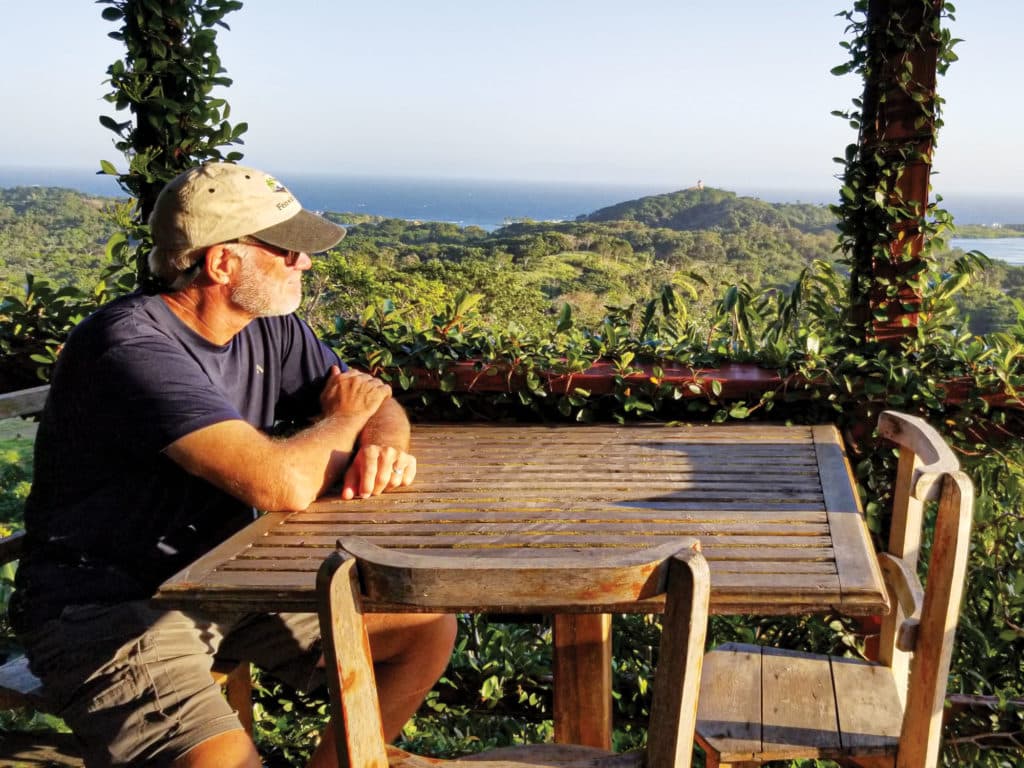
Great swaths of time stretched out in front of us, but Ken and I couldn’t seem to push through the layers of heat-induced lassitude and emotional malaise to accomplish anything. We watched all seven episodes of Tiger King on Netflix, while our peers energetically engaged in boat repairs and artistic endeavors. I thought about writing a song on the ukulele called “How I Wasted a Perfectly Good Pandemic.” I fantasized about throwing a Gilligan’s Island party and talent show with the cruising community. Everyone would be told to come as a character from the legendary TV show and then perform some sort of act in character. I could envision exactly who each cruiser should play. But I couldn’t reconcile hosting such an event while practicing social distancing.
Ken and I had daily discussions on what our next move should be. Before the pandemic, we had anticipated a leisurely sail to Florida via Belize and Isla Mujeres, Mexico. Now Belize’s borders were closed, and we imagined Mexico would follow suit. The coronavirus had not yet shown its face in Roatan, but social unrest was growing and the hurricane season was approaching. Should we stay and hope for the best, or leave the boat and try to arrange a charter flight? That would mean boarding a plane—which seemed like a viral incubator. Guatemala had closed its borders, but we could wait for it to reopen and sail Mary T back to Rio Dulce, an excellent hurricane hole. But what if Guatemala remained closed? We estimated that sailing to Florida would take five to six days without stopping, but what if we needed a port of refuge for health issues, bad weather or boat problems? Stories of cruisers desperate for a place to land were circulating on the internet.
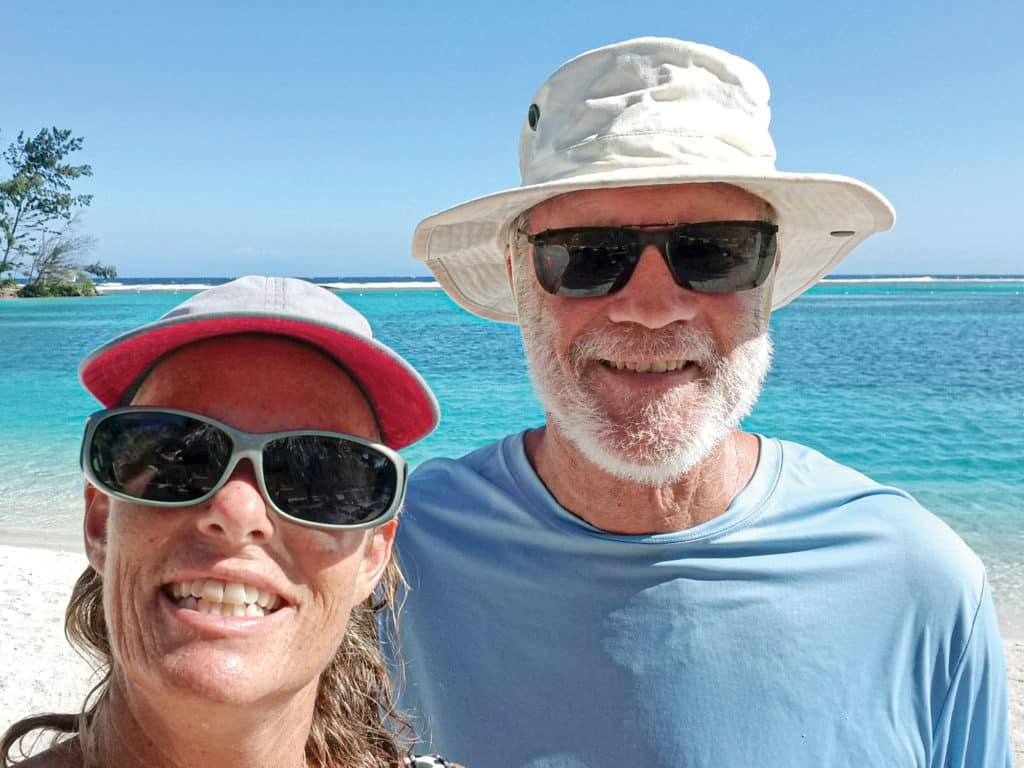
A persistent pain in Ken’s right kidney accompanied by rust-colored urine were a growing source of anxiety. When his worry became all consuming, I suggested we find a lab and submit a urine sample. It was our first trip out in more than two weeks. Wearing gloves and makeshift masks, and with urine sample in hand, we entered the delightfully air-conditioned vehicle driven by a knowledgeable, local woman. Driving through town, we witnessed endless lines of people snaking down sidewalks outside banks and Eldon’s Supermarket. The new system of limited days for outings may have been creating the very situation it was intended to mitigate—large gatherings of people. The trip to the lab was short, and we were attended to immediately. For $3 they’d conduct the tests and send the results via email in less than two hours. Wow.
The results revealed blood in the urine but no infection. Ken’s urologist in Florida, to whom he emailed the results, said it was probably a kidney stone. He suggested drinking lots of water and taking Tylenol for pain. If the pain intensified, Ken should go for a CT scan. A few days later, Ken’s urine returned to a normal color, but the dull ache remained, so he went for the CT scan to rule out anything scary. The hospital was fairly modern, but we were surprised to see few employees wearing masks. The scan showed nothing out of the ordinary in the right kidney. Much relieved, Ken agreed we should sail home to Florida. Shortly thereafter, a weather window opened.
On May 14, we kissed French Cay Harbor goodbye and wove through the reef into deep blue water, where the ocean swells greeted us with open arms. Being at sea presented a new set of challenges. It felt incredibly liberating, but having been at a dock for over two months, we were both feeling a bit queasy from the motion. And it had been five years since we’d made a significant passage at sea, so our seamanship was on the rusty side. Shortly after dropping the dock lines, we learned the big weather window that was predicted had suddenly narrowed. In five days, a major storm would sweep the Florida Straits. Could we go fast enough to arrive in Key West before getting clobbered?
By midnight the first day, my queasiness had passed, and I felt remarkably at ease pitching through the waves in utter darkness. Mary T was handling it with aplomb. I marveled at how one can feel so comfortable and safe in what’s really a pretty precarious situation.
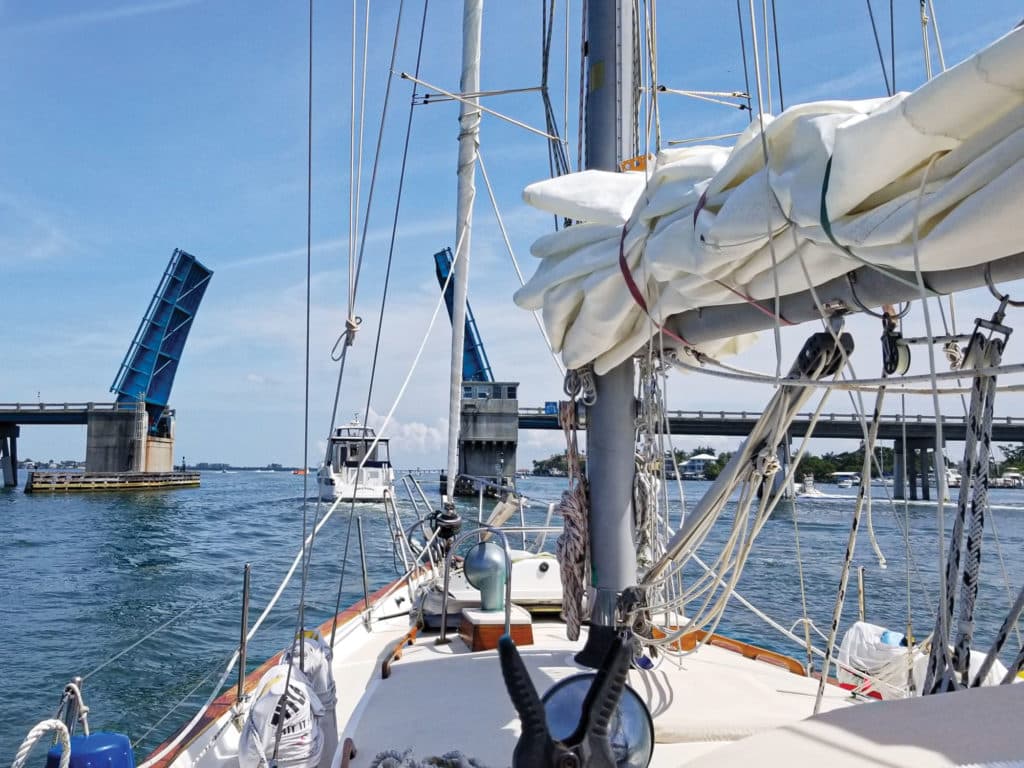
My joy and ease were soon erased by unaccountable blips on the radar. I looked out on the water but could see no lights on the horizon or ships on the AIS. So what were these blips? Pirates! My mouth went dry as I was seized with terror. I woke up Ken to come have a look. We discussed our options, and my fear intensified as the blips grew closer. Then as mysteriously as they appeared on radar, the two blips morphed into four and faded. Hmm. Was it rain or the echoes of a large ship that later appeared on AIS? I sheepishly slunk below as Ken took his watch.
By daybreak, we’d found the Gulf Stream and were flying north at 8 knots. As we progressed, I kept examining our speed and counting the remaining miles to Key West. Before sunset on our second day, we determined we could probably make it before the predicted storm. Woohoo! That night, I lay awake on a wet bunk longing for sleep. We apparently had some leaks around deck fittings on the leeward side, which was constantly awash in green water. I was trying to squeeze myself as far away from the wet part as possible when we suddenly started pounding hard through steep, nasty waves. I’d forgotten about the shallow banks to the east of Isla Mujeres and had plotted a course right through it.
In the afternoon on day four, the wind finally died, and we found ourselves motoring through the Florida Straits in calm waters. We basked in the sun and relaxed until nightfall, when we were treated to an unexpected thunderstorm. Lightning illuminated the sky in every direction, rain lashed Mary T’s deck, and wind gusts heeled her over, while we hunkered below, longing for our mommies to come rescue us. But overall, it was a fabulous passage. We enjoyed consistently favorable winds averaging 15 knots, and did not see a speck of garbage in the water. The ocean was clearly benefiting from the pandemic.
After four days and five hours, we made landfall in Key West on May 18, ahead of the big storm. We checked in with Customs and Border Patrol online and were asked nary a question about our health. There was no talk of quarantining. CBP said we were free to go wherever we wished. We were stunned. Compared with the rest of the world, our country seemed to be taking the pandemic very lightly.
A few days sailing up the Gulf Coast and a final leg on the Intracoastal Waterway brought us back to our condo in Bradenton, Florida, where we are currently enjoying the luxuries of landlubbing. As I write, COVID-19 is exploding all around us, but there are surprisingly few restrictions. We play it safe, wearing masks and washing our hands like there’s no tomorrow. We are eternally grateful to those working in essential jobs, allowing us to stay home.
Sometimes I wax nostalgic about Roatan, where the virus finally made inroads. I hope the islanders and cruisers remain safe. May we all emerge from this more compassionate, wiser, and kinder to our planet. Without all the distractions one normally enjoys, we have more time to reflect on how to lead a meaningful life. And, of course, plan our next cruise!
Amy Flannery and her husband, Ken Kurlychek, are waiting out hurricane season at their home in Bradenton, Florida, while Mary T, a 1984 Morgan 38-4, spends the season on the hard. The development of the pandemic will determine their future cruising plans.








